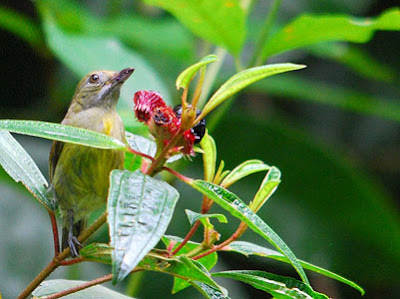Upon our arrival at this locality, the trio of us – James, Choo Eng and yours truly, were greeted by a tropical downpour. The forests here are not called tropical rainforest for no apparent reason and getting wet is all part of birding in the tropics. One thing that one can always look forward to after is the fact that most birds will be out foraging or simply drying themselves out. In our case, we had stunning views of the resident pair of Wallace’s Hawk-eagles greeting the first few rays of the morning sun on a slightly exposed perch.


Our presence, at such a distance, provided the perfect opportunity for a prolonged observation of the pair preening and preparing themselves for the day ahead. There is a recognizable difference between the two as one of them has a more rufous colour on the sides of the head. As the size difference was quite insignificant, I can only guess that it is the male bird.

When things got a little “hot”, the pair decided to give each other some breathing space and moved apart.



We found these beautiful eagles nesting during our maiden trip to this locality back in December 2009. Here are a few images taken during that time of the nest and one of the eagles. Being rather scarce, the discovery of the nest was quite an exciting find and had a fairytale ending when a couple of months later, the pair successfully raised another of its kind into the world.



The Wreathed Hornbill gave me another teasing performance when it flew overhead. My window of opportunities, literally, is when this magnificent bird passes gaps along the forest canopy. In between the cursing and swearing, I did manage to capture a few shots.

These short bushes with these reddish berries (I really need to brush up on my knowledge of plants) are quite fancied by birds - especially Flowerpeckers. The Orange-bellied Flowerpecker is by no means uncommon but all my past attempts to capture a decent image ended in vain. But today, this handsome male decided to give me a break by staying put long enough on a slightly exposed perch while enjoying his breakfast. 

Of all the “laws”, official or otherwise, Murphy’s Law is the one I can really relate to ever since I took up bird photography. When in the presence of a striking male and a drab female, like in this case a pair of Crimson-breasted Flowerpeckers, more often than not the striking one will be camera-shy and the drab one is not.

A family of Checker-throated Woodpeckers foraging along the mid level of the forest immediately captured my undivided attention. Unfortunately, the dim lighting and active nature of the birds prevented me from obtaining any really good shots despite the close distance. 

While observing the Woodpeckers, I was distracted momentarily by the presence of another forest dweller. You know it had to be something equally, if not more captivating to have stolen the limelight from the former and it certainly was - a cracking male Dark-throated Oriole. Initially, he was quite hidden by the dense foliage. 




4 comments:
Nice shot mun of the WHE.
http://1.bp.blogspot.com/-H3aFAztQExQ/TdnMJvqbrxI/AAAAAAAAEsk/DXngrFz_7mQ/s1600/whe3.jpg
this pic here you can see the difference of the tail banding which help you differentiate the sexes. Great Shot
Hope this can help you a bit.
http://terence-ang.blogspot.com/2010/06/wallaces-hawk-eagle-nisaetus-nanus.html
Thanks Terrence for all your help on the id of the eagles.
Mun,
I think you got the sexes correct on your earlier identification.
The bird which faces away which have more rufous on the face is the male bird.
The darker faces and look towards our direction is the female bird.
Compare the 2nd pale band of the bird whic the right and faces us have narrower band then the bird on the lef
Post a Comment